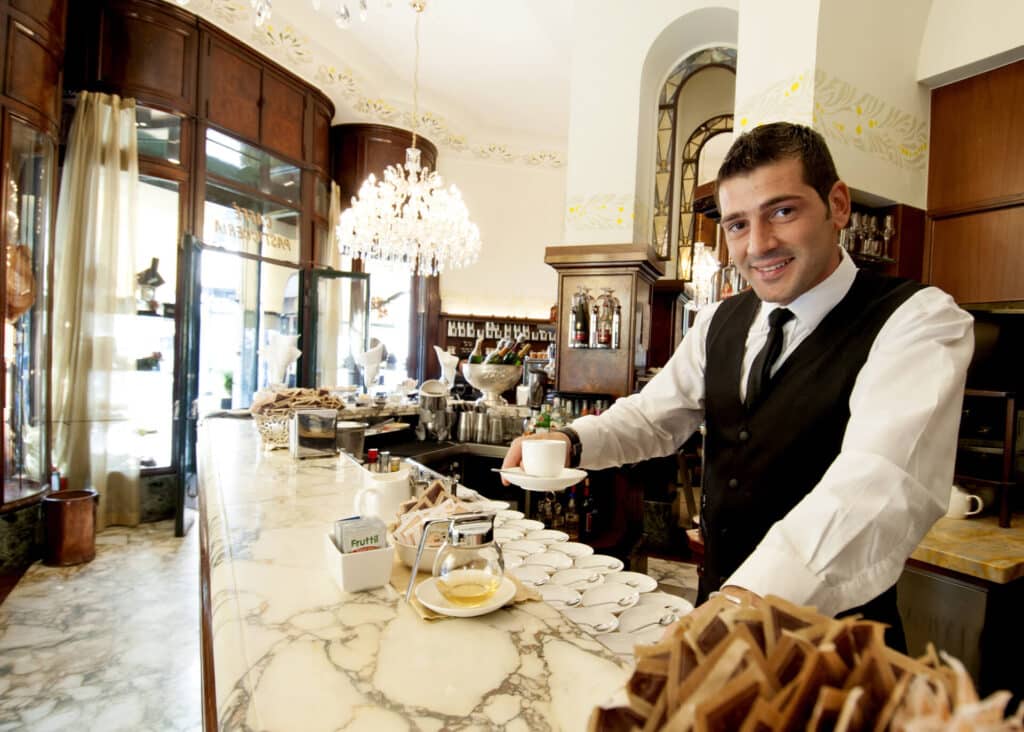You are standing in line at your local coffee shop waiting to order the cappuccino your soul craves. Suddenly your ear catches something interesting: the person in front of you orders a bone dry cappuccino. It makes you wonder: what is the difference between a classic and a bone dry cappuccino? Is this something you should try?
Where does the name “cappuccino” come from?
The cappuccino drink was named after the Capuchin friars due to the color of their robes, similar to milky coffee.
The first cappuccinos, called the ‘Kapuziner,’ were served in Viennese coffee houses as early as the 1700s. It was coffee with cream and sugar, and later they added spices to the recipe.
Cappuccino coffee made with espresso was invented in Italy at the beginning of the XX century when the espresso machine became popular. In the beginning, the espresso machines were large and hard to operate, so only experienced baristas could make coffee.
Italian people would gather and spend hours at specialized cafes, drinking their coffee, engaging in discussions, and reading books. Their cappuccinos were served Viennese style, with whipped cream and shaved chocolate or cinnamon on top.
After World War II, improved and smaller espresso machines became popular, opening a new era for cappuccino coffee. More and more cafes began to make cappuccino as we know it today, using espresso and steamed and frothed milk. This smooth coffee drink gained popularity in continental Europe, England, and eventually, worldwide.
Cappuccino became popular in the United States around the 1980s. Starbucks and other coffee chains helped spread the coffee drinking culture, promoting different variations of cappuccinos, lattes, macchiatos, and other espresso-based drinks.

Different cappuccino types
Classic cappuccino has not changed much since its inception. However, today there are some cappuccino variations that you may come across or hear baristas talking about in the coffee shop: wet cappuccino, dry cappuccino, and bone dry cappuccino. So let’s find out how each beverage varies in flavor, foam, milk, and espresso ratio.
Classic cappuccino
Any barista would tell you that a regular cappuccino is created following the rule of thirds: an equal amount of espresso, steamed milk, and frothed milk. Following this rule results in a creamy and smooth coffee beverage.
If you want to make a classic cappuccino at home, grab your Moka Pot and follow this recipe:
Step 1: Brew your preferred coffee in your Moka Pot and pour the desired amount into your cup. It should contain about one-third of the cup.
Step 2: Fill in the same amount of scalded milk. Now you should have around two-thirds of your cup full.
Step 3: Create the milk froth for your cappuccino. It can be done in the following ways:
- Use a pot. Pour milk into it, heat it on the stove on low heat and whisk until you see bubbles forming.
- Use a French press. Pour heated milk into a French press. Insert the plunger and move it up and down while holding the lid. Keep on going until the milk doubles in volume.
- Use a handheld milk frother. Heat the milk to scalding and pour it into a tall container. Hold it at an angle while moving the frother up and down until foam forms (about 20 seconds). Tap the container on the counter to pop the large bubbles.
- Use a steam wand. This method requires a coffee machine that has a milk-steaming attachment. Pour the cold milk into a metal pitcher or cup. Insert the steam wand below the milk surface. Try to keep the tip of the wand near the pitcher’s side. Create a vortex in the milk until bubbles are formed.
When you have the froth ready, top up your cappuccino with a thick layer of it. Next, you can sprinkle powdered or shaved chocolate or cinnamon on top. And here you have it, the classic cappuccino that would please any coffee lover.

Wet cappuccino
A wet cappuccino is excellent for those who prefer their coffee milky. It contains the standard espresso amount but less foam and more steamed milk. Usually, baristas prefer to make wet cappuccinos over bone dry cappuccinos. The main reason is that adding steamed milk to espresso is quicker than whipping up a lot of milk foam.
The taste of wet cappuccino is creamy and elegant, with a minimal bite from the one shot of espresso.
Do you like to have your coffee beverage with a lot of milk and a minimal amount of foam? Then you are on the verge of drinking a caffe latte.
Reasons coffee lovers prefer wet cappuccino:
- More steamed milk will result in a creamier texture.
- More milk means more options for latte art.
- Less coffee bitterness and more sweetness from the extra steamed milk.
Why wet cappuccino may not be the best choice for you:
- The extra steamed milk makes the coffee taste lighter, which is not optimal if you expect a caffeine kick.
Dry cappuccino
A dry cappuccino contains more frothed milk and much less steamed milk than a regular one. It is often said to be similar to a macchiato.
To prepare a dry cappuccino, brew one espresso shot using your espresso machine or your Moka Pot. Then, steam milk as you normally would for a classic cappuccino.
Fill less than one-third of the milk in the cup. The milk in the coffee drink should be just enough to add a light color. Add a thick layer of foam on top.
Reasons to try a dry cappuccino:
- Beverage of choice aside from black coffee for those counting calories due to a smaller amount of milk.
- Richer and bolder coffee flavor.
- Froth keeps your coffee hot longer.
Reasons you may not like a dry cappuccino:
- You do not like froth.
- You prefer your coffee to last longer.
- It is not as smooth as a standard cappuccino.

Bone dry cappuccino
A bone dry cappuccino has the biggest froth amount from all the variations discussed here. It might be a good option for slightly lactose intolerant people or those who prefer a stronger coffee. Bone dry cappuccino does not contain any liquid milk to dilute espresso. It is worth trying if you are a coffee connoisseur who typically opts for a macchiato.
So what does a bone dry cappuccino taste like? When indulging in bone dry cappuccino, you will experience a bolder flavor of coffee with a bit more tartness. A classic cappuccino is sweeter and tastes more smooth due to the steamed milk used for making it, but you may not want that sweetness in your drink that would cover up the espresso flavor.
The milk foam acts like a filter that slightly softens the bitterness of the espresso yet allows you to taste and appreciate the coffee. It may be important if you enjoy your specialty coffee and don’t want any distractions from the coffee flavor.

How to make a bone dry cappuccino
Now that you know what a bone dry cappuccino is, you can head to your favorite coffee shop or make it at home and save some cash. Like the classic cappuccino, you will need only two ingredients: coffee beans for your espresso base and milk to create the foam.
Step 1: Make an espresso.
As a home barista, you probably know that espresso is the base for most coffee drinks. So pour it into your cup before adding anything else.
Step 2: Froth the milk.
Since the bone dry cappuccino recipe does not require steamed milk, you make the foam. Again, use any frothing tool or technique that works best for you.
Step 3: Tap the pitcher.
Once you achieve the desired foam consistency, tap the bottom of your pitcher on the counter. This is especially important when making a bone dry cappuccino as it helps to separate the foam and milk.
Step 4: Spoon the foam on top of the espresso.
While you can try to pour the foam directly out of the pitcher into your cup, it is best to use a spoon to scoop out the foam to ensure that no liquid milk gets into your bone dry cappuccino. After all, that’s the whole point of making it.

How to choose the best cappuccino?
If you are relatively new to the coffee world and choose the coffee that is not your liking, your entire experience could be ruined. It could even deter you from ever giving cappuccinos another shot. So which variation of cappuccino is the best for you?
Classic cappuccino is perfect for those who prefer the traditional way of making this Italian drink. It contains equal parts of espresso, milk, and foam and has a nice balance of tartness and creaminess. If you like the taste of coffee but prefer a more creamy texture, this type of cappuccino is for you.
Wet cappuccino is perfect for flat white lovers who want something similar but with less espresso. If you feel you should cut your caffeine intake a bit, the wet cappuccino is your go-to drink.
Dry cappuccino is the closest to a macchiato. It is a good option if you feel like having a bigger cup of coffee with more frothed milk.
Bone dry cappuccino entirely lacks milk and has a lot of foam to soften the tartness of espresso. Ask for your drink bone dry if you like tasting espresso, only slightly toned down by the layer of milk foam on top.
As you may have figured out, the main difference between classic, wet, dry, and bone dry cappuccino is the milk-to-foam ratio. While it may not sound significant, even the slightest nuances can count when it comes to personal taste. So if you’ve just learned to correctly name your preferred coffee beverage with a lot of foam on top, congratulations! Now you can head to your favorite coffee shop and wink to a barista when ordering a bone dry cappuccino.
